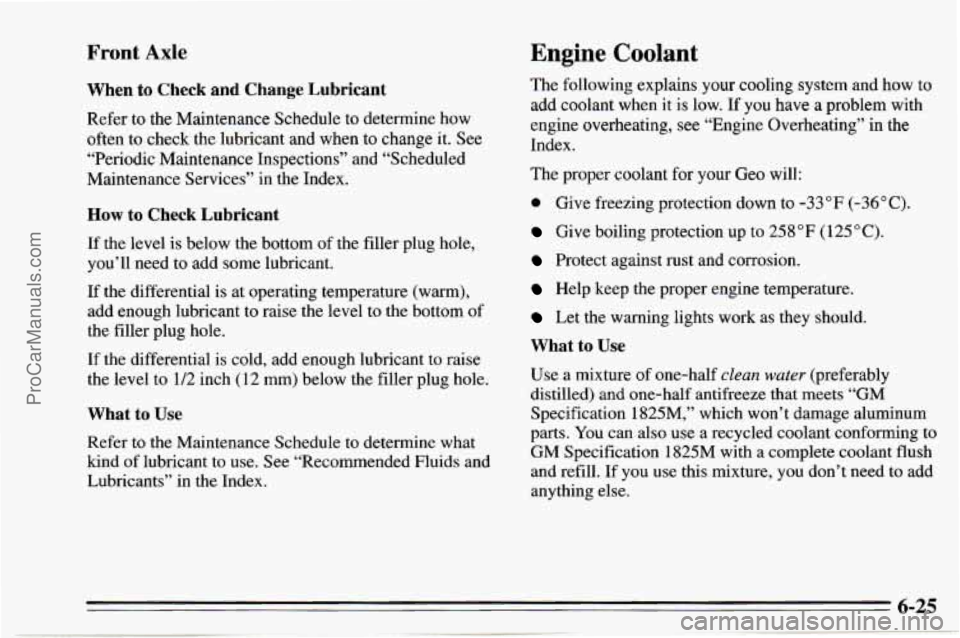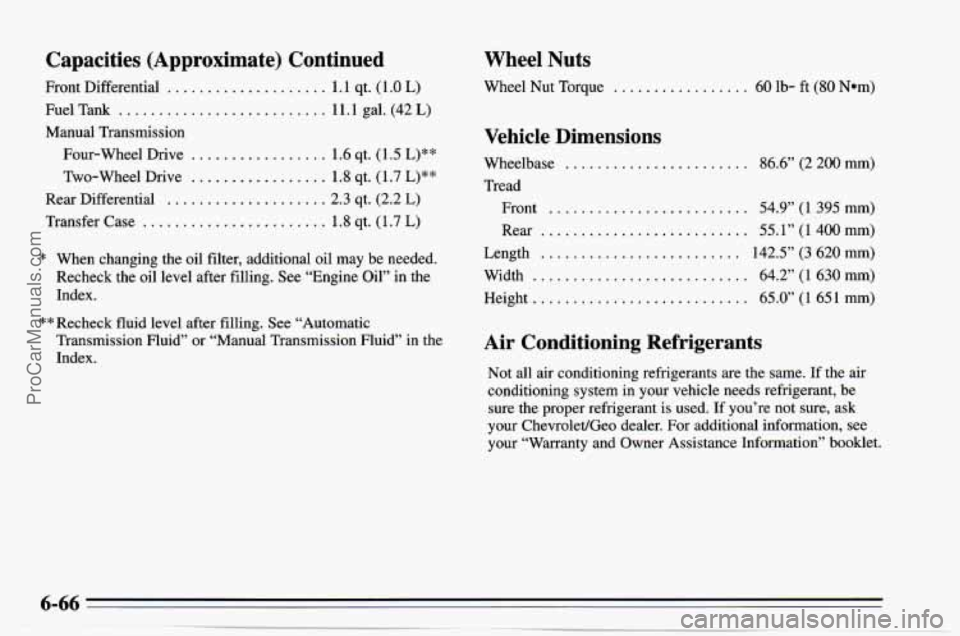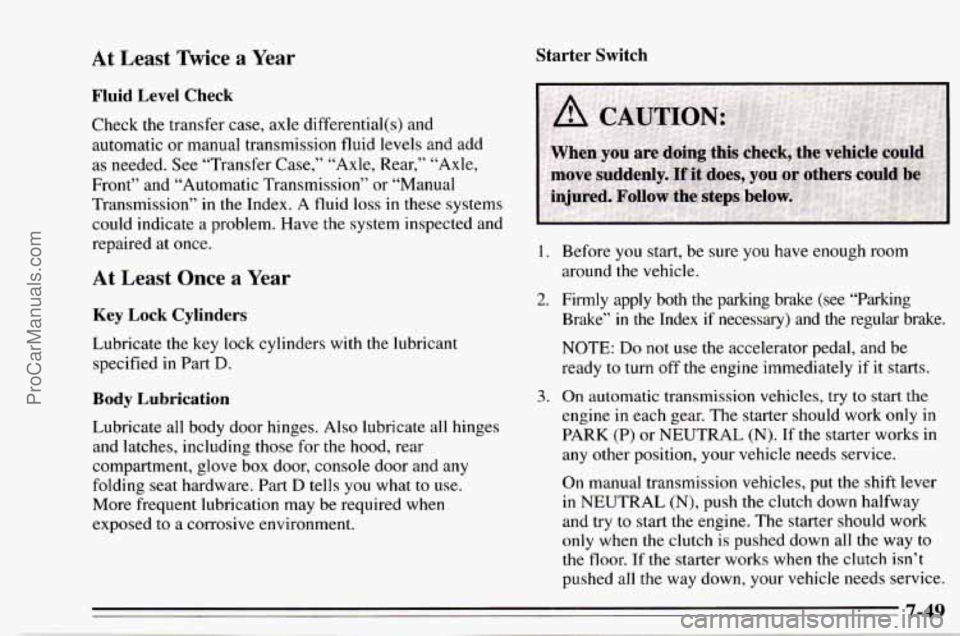differential CHEVROLET TRACKER 1995 Owners Manual
[x] Cancel search | Manufacturer: CHEVROLET, Model Year: 1995, Model line: TRACKER, Model: CHEVROLET TRACKER 1995Pages: 354, PDF Size: 18.24 MB
Page 236 of 354

Front Axle Engine Coolant
When to Check and Change Lubricant
Refer to the Maintenance Schedule to determine how
often to check the lubricant and when to change it. See
“Periodic Maintenance Inspections” and “Scheduled
Maintenance Services” in the Index.
How to Check Lubricant
If the level is below the bottom of the filler plug hole,
you’ll need to add some lubricant.
If the differential is at operating temperature (warm),
add enough lubricant to raise the level to the bottom of
the filler plug hole.
If the differential is cold, add enough lubricant to raise
the level to 1/2 inch (12 mm) below the filler plug hole.
What to Use
Refer to the Maintenance Schedule to determine what
kind of lubricant to use. See “Recommended Fluids and
Lubricants” in the Index. The following explains
your cooling
system and how to
add coolant when it is low. If you have a problem with
engine overheating, see “Engine Overheating’’ in the
Index.
The proper coolant for your Geo will:
0 Give freezing protection down to -33°F (-36°C).
Give boiling protection up to 258°F (125°C).
Protect against rust and corrosion.
Help keep the proper engine temperature.
Let the warning lights work as they should.
What to Use
Use a mixture of one-half clean water (preferably
distilled) and one-half antifreeze that meets
“GM
Specification 1825M,” which won’t damage aluminum
parts. You can also use a recycled coolant conforming to
GM Specification 1825M with a complete coolant flush
and refill. If you use this mixture, you don’t need to add
anything else.
ProCarManuals.com
Page 277 of 354

Capacities (Approximate) Continued
Front Differential .................... 1.1 qt. (1 .O L)
Fuel Tank .......................... 11.1 gal. (42 L)
Manual Transmission
Four-wheel Drive
................. 1.6 qt. (1.5 L)**
Two-Wheel Drive ................. 1.8 qt. (1.7 L)**
Rear Differential .................... 2.3 qt. (2.2 L)
Transfer Case ....................... 1.8 qt. (1.7 L)
* When changing the oil filter, additional oil may be needed.
Recheck the oil level after filling. See “Engine Oil” in the
Index.
** Recheck fluid level after filling. See “Automatic
Transmission Fluid” or “Manual Transmission Fluid” in the
Index.
Wheel Nuts
Wheel Nut Torque ................. 60 lb- ft (80 Nom)
Vehicle Dimensions
Wheelbase ....................... 86.6” (2 200 mm)
Tread Front
......................... 54.9” (1 395 mm)
Rear
.......................... 55.1” (1 400 mm)
Length
......................... 142.5” (3 620 mm)
Width
........................... 64.2” (1 630 mm)
Height
........................... 65.0” (1 65 1 mm)
Air Conditioning Refrigerants
Not all air conditioning refrigerants are the same. If the air
conditioning system
in your vehicle needs refrigerant, be
sure the proper refrigerant is used. If you’re not sure, ask
your Chevrolet/Geo dealer.
For additional information, see
your “Warranty and Owner Assistance Information” booklet.
ProCarManuals.com
Page 326 of 354

At Least mice a Year Starter Switch
Fluid Level Check
Check the transfer case, axle differential(s) and
automatic or manual transmission fluid levels and add
as needed.
See “Transfer Case,” “Axle, Rear,” “Axle,
Front” and “Automatic Transmission” or “Manual
Transmission” in the Index.
A fluid loss in these systems
could indicate
a problem. Have the system inspected and
repaired at
once.
At Least Once a Year
Key Lock Cylinders
Lubricate the key lock cylinders with the lubricant
specified
in Part D.
Body Lubrication
Lubricate all body door hinges. Also lubricate all hinges
and latches, including those for the hood, rear
compartment, glove box door, console door and any
folding seat hardware. Part
D tells you what to use.
More frequent lubrication may be required when
exposed
to a corrosive environment.
1. Before you start, be sure you have enough room
around the vehicle.
2. Firmly apply both the parking brake (see “Parking
Brake”
in the Index if necessary) and the regular brake.
NOTE:
Do not use the accelerator pedal, and be
ready to turn
off the engine immediately if it starts.
3. On automatic transmission vehicles, try to start the
engine in each gear. The starter should work only in
PARK (P) or NEUTRAL (N). If the starter works in
any other position, your vehicle needs service.
On manual transmission vehicles, put the shift lever
in
NEUTRAL (N), push the clutch down halfway
and try
to start the engine. The starter should work
only when the clutch is pushed down all the way to
the floor. If the starter works when the clutch isn’t
pushed
all the way down, your vehicle needs service.
7-49
ProCarManuals.com